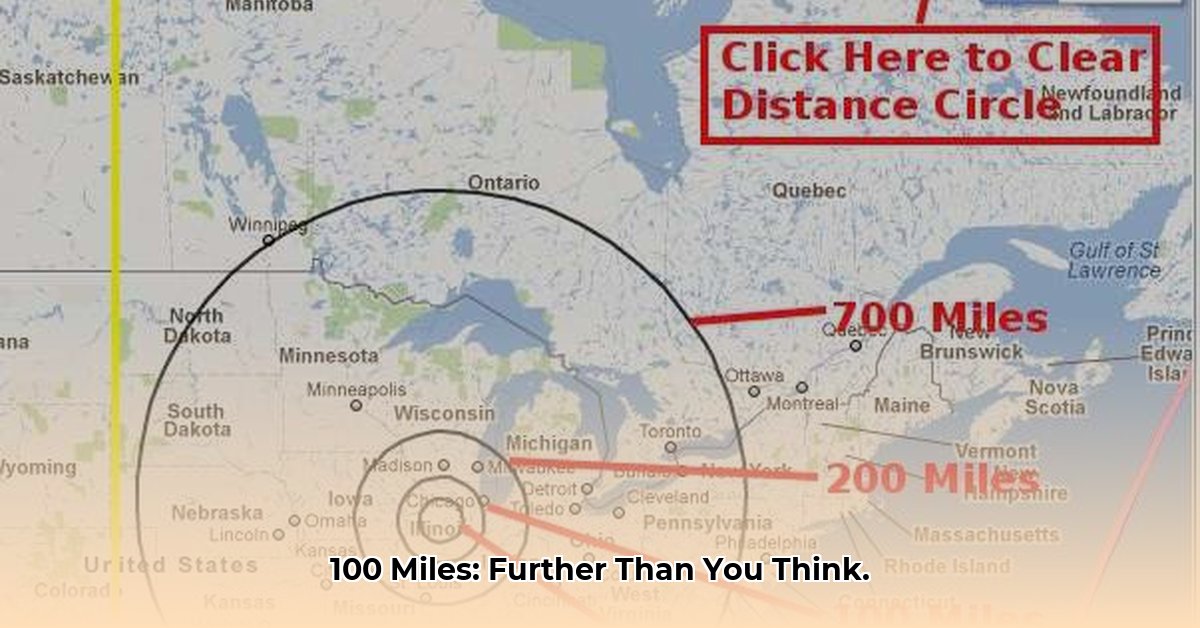100 miles. It sounds like a lot, but how far is it really? This article explores what 100 miles means in terms of travel time, real-world comparisons, and even how our minds perceive distance.
Understanding 100 Miles: Time, Perceptions, and Comparisons
Let’s explore what 100 miles truly represents. It’s more than just a number; it’s a journey shaped by how we travel, the landscape we cross, and even our own psychology.
Travel Time: A Matter of Perspective
Traveling 100 miles can feel like a breeze or an eternity depending on your mode of transport. A car journey at 65 mph might take around 1 hour and 30 minutes, while walking the same distance at 3 mph could take over 33 hours! Here’s a quick comparison:
| Mode of Transport | Typical Speed (mph) | Estimated Time |
|---|---|---|
| Car | 65 | ~1 hour, 30 minutes |
| Bus | 55 | ~1 hour, 50 minutes |
| Train | 80 | ~1 hour, 15 minutes |
| Bicycle | 12 | ~8 hours, 20 minutes |
| Walking | 3 | ~33 hours |
Remember, these are just estimates. Real-world travel times can vary due to traffic, weather, and those unexpected detours life throws our way.
Visualizing the Distance: Beyond Numbers
Imagine a 100-mile radius around your city. That’s the area encompassed by 100 miles. It might include neighboring towns, stretches of coastline, or even parts of different states. For a relatable example, 100 miles is roughly the distance between New York City and Philadelphia, or Los Angeles and San Diego.
Miles to Kilometers: A Global Perspective
For our international readers, 100 miles converts to approximately 160.9 kilometers. A handy rule of thumb: 1 mile is about 1.6 kilometers.
Real-World Applications: From Commutes to Centuries
A 100-mile daily commute is a significant commitment, impacting lifestyle and free time. On the other hand, a 100-mile bike ride, known as a “century ride,” represents a challenging yet achievable goal for many cyclists.
The Psychology of Distance: Perception vs. Reality
Interestingly, 100 miles can feel longer or shorter depending on the route. A winding mountain road might feel longer than a straight highway, even if the mileage is the same. Our perception of distance is influenced by speed, scenery, and even our mood.
Visualizing 100 Miles: Maps, Diagrams, and Real-World Examples
Let’s go beyond numbers and explore different ways to visualize 100 miles, making this abstract concept more concrete.
Maps and Technology: Your Virtual Yardstick
Online mapping tools (like CalcMaps) allow you to draw a 100-mile radius, providing a visual representation of that distance. While Google Maps doesn’t have this specific feature, you can still manually measure distances. OpenStreetMap, a more customizable alternative, may require more effort for radius visualization.
Diagrams: Making Distance Tangible
A simple diagram can effectively represent 100 miles. Imagine a scale where 1 inch equals 10 miles; a 10-inch line then represents 100 miles. Compare this to the distance between familiar cities on a bar graph to further solidify your understanding.
Real-World Comparisons: Bridging the Gap
Thinking about familiar journeys can help. Imagine consecutive trips between two nearby cities adding up to 100 miles. Or visualize a national park that fits within a 100-mile radius.
100 Miles to Kilometers: Conversion and Practical Use
Let’s break down the conversion from miles to kilometers and see how it applies in everyday life.
The Conversion: Miles to Metric
100 miles equals 160.934 kilometers. The quick conversion? Multiply miles by 1.6 for an approximate kilometer equivalent.
Practical Applications: From Cycling to Fuel Efficiency
This conversion is useful in various contexts. A 100-mile “century ride” becomes a 160.9-kilometer challenge. Marathon training over several weeks might accumulate close to 160 kilometers. Understanding fuel efficiency comparisons (mpg vs. liters per 100 kilometers) also benefits from this conversion.
Travel Time Estimates
Here’s a general guide for 100-mile travel times:
| Mode of Transport | Typical Speed (mph/kph) | Estimated Time |
|---|---|---|
| Car | 60/97 | ~1.7 hours |
| Train | 80/129 | ~1.25 hours |
| Bicycle | 15/24 | ~6.7 hours |
| Walking | 3/5 | > 33 hours |
These are, of course, approximations. Real-world conditions will likely influence actual travel time.
This article aimed to provide a comprehensive understanding of 100 miles, moving beyond a simple numerical value to exploring its real-world significance and perceptual nuances. We’ve covered travel times across various modes of transportation, offered visual aids like maps and diagrams, and examined the psychological factors affecting our perception of distance. Additionally, we’ve explained the conversion to kilometers and illustrated its practical applications. While the exact perception of distance can be subjective and influenced by various factors, this article provides a framework for understanding and appreciating the magnitude of 100 miles. Future research in areas like cognitive psychology and transportation technology may further refine our understanding of distance and travel, leading to even more accurate and personalized estimations in the years to come.
- How to Stop Apps From Running in the Background to Boost Your - December 1, 2025
- How To Move Apps On Your Droid For Better Organization - November 30, 2025
- How to Move Apps on Android for Better Organization - November 29, 2025










